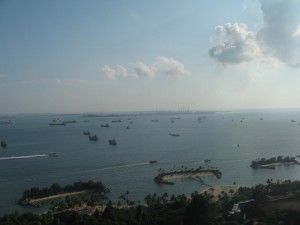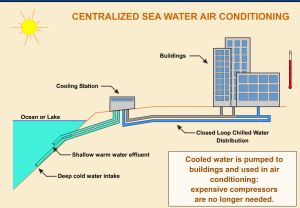It is no secret that cities use up a large bulk of the energy budget. Thus sourcing for more renewable and reliable sources of energy is always important.
Ocean Thermal Energy Conversion (abbreviated OTEC), interestingly generates energy through the temperature difference between surface and deep sea waters (1).
 (2)
(2)
The idea is very similar to coal-fired power plants, where heat is used to excite a fluid, in this case it is ammonia (1), and the excited fluid moves and turns a turbine that produces energy. I have a few personal thoughts on this, and by any means I may be wrong.
It is definitely a very interesting idea. Although it is stated that hot & cold waters are respectively drawn out from the shallow and deep waters, and consequently the mixed, thermally averaged water is released back, the energy used to turn the turbines have to come from somewhere. Therefore the ocean ‘system’ actually loses energy as a whole. As there is a net loss of energy from the ocean to turn the turbines, I wonder whether, on a large scale, it is viable to possibly also conveniently mitigate the onset of rising sea temperatures & its subsequent ramifications on wildlife and habitat?
However I also question its effectiveness to produce energy. Comparing it to current coal plants, where coals is fired to produce steam, the temperature of coal can go up to almost 2000°C (3). The maximum difference in temperature between the coldest and warmest waters would be merely ~20°C. How effective will this technology be in displacing conventional fossil fuels?
In a city like Singapore, if this technology would be proven effective, I would think that this would be pretty viable for us, as we are situated right smack in the tropics, possibly having one of the highest surface sea temperatures.
So many ideas, yet so unattainable.
References
- What is OTEC –. OTEC news. Retrieved 28 October 2016, from http://www.otecnews.org/what-is-otec/
- Ocean Thermal Energy Conversion | Makai Ocean Engineering. Makai.com. Retrieved 28 October 2016, from http://www.makai.com/ocean-thermal-energy-conversion/
- Coal and Charcoal. Anvilfire.com. Retrieved 30 October 2016, from http://www.anvilfire.com/FAQs/coal.php





